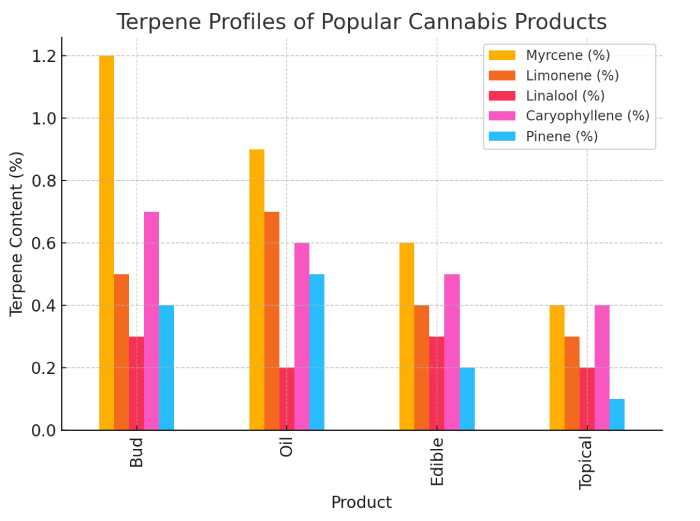Terpenes are aromatic compounds found in many plants, including cannabis. They are responsible for the distinctive smells and flavors of different cannabis strains and play a crucial role in the plant’s therapeutic properties.
Understanding terpenes can enhance your cannabis experience, whether you’re a recreational user or seeking medical benefits. Below, we review the benefits, effects, and uses you can expect when seeing terpenes listed on your Canadian cannabis packages.
Table of Contents
- What Are Terpenes?
- Top 10 Terpenes in Cannabis
- How Terpenes Affect Sativa and Indica Strains
- Benefits of Cannabis Terpenes
- Effects of Common Terpenes
- Uses of Terpenes in Cannabis
- Growing Cannabis with High Terpene Content
- Steps and Tasks
- Required Assets
- Risks and Considerations
- Forms of Terpene-Rich Cannabis Products
What Are Terpenes?
Terpenes are organic compounds produced by various plants, including cannabis. They serve multiple purposes, such as attracting pollinators, deterring herbivores, and protecting plants from environmental stressors.
In cannabis, terpenes contribute to the plant’s aroma, flavor, and effects. Scientifically, terpenes are major biosynthetic building blocks, comprising more than 30,000 compounds with the formula (C5H8)n for n ≥ 2.
Top 10 Terpenes in Cannabis
- Myrcene: Known for its earthy, musky scent, myrcene is found in many cannabis strains and contributes to their sedative effects.
- Limonene: This citrus-scented terpene is uplifting and energizing, often found in strains that help with mood enhancement.
- Linalool: With a floral lavender aroma, linalool is known for its calming and relaxing properties.
- Caryophyllene: This spicy, peppery terpene has anti-inflammatory and pain-relieving effects.
- Pinene: As the name suggests, pinene has a pine-like aroma and can help improve focus and respiratory functions.
- Humulene: Earthy and woody, humulene is known for its anti-inflammatory and appetite-suppressing properties.
- Terpinolene: Found in many sativa strains, terpinolene has a fresh, herbal, and slightly floral scent, known for its uplifting effects.
- Ocimene: This terpene has a sweet, citrusy, and herbal aroma, known for its antifungal and antiseptic properties.
- Geraniol: With a rose-like aroma, geraniol is often used in aromatherapy for its relaxing effects.
- Borneol: Known for its minty scent, borneol has calming effects and is used in traditional medicine.
How Terpenes Affect Sativa and Indica Strains
Terpenes play a significant role in distinguishing the effects of sativa and indica strains. Sativa strains typically contain terpenes like terpinolene and limonene, which are known for their uplifting and energizing effects. Indica strains, on the other hand, often have higher levels of myrcene and linalool, contributing to their calming and sedative properties.
Benefits of Cannabis Terpenes
Cannabis terpenes offer a wide range of benefits, from enhancing the flavor and aroma of cannabis products to providing therapeutic effects. They can help manage stress, anxiety, pain, inflammation, and other health conditions. The entourage effect, a synergy between cannabinoids and terpenes, enhances the overall efficacy of cannabis.
Effects of Common Terpenes
Each terpene has unique effects:
- Myrcene: Sedative, muscle relaxant
- Limonene: Mood enhancer, stress reliever
- Linalool: Anxiolytic, sedative
- Caryophyllene: Anti-inflammatory, pain relief
- Pinene: Alertness, respiratory aid
Uses of Terpenes in Cannabis
Terpenes are used in various cannabis products to enhance their effects and flavors. They are added to oils, tinctures, edibles, and topicals to create a more tailored and effective user experience. Terpenes are also used in aromatherapy and wellness products for their therapeutic properties.
Growing Cannabis with High Terpene Content

Steps and Tasks
- Choose the Right Strain: Select strains known for high terpene content.
- Optimize Growing Conditions: Maintain optimal temperature, humidity, and light levels.
- Proper Nutrients: Use nutrient-rich soil and fertilizers to promote terpene production.
- Harvesting at the Right Time: Harvest plants when terpenes are at their peak, usually just before full maturity.
- Curing Properly: Cure the cannabis slowly to preserve terpene profiles.
Required Assets
- Quality seeds or clones
- Nutrient-rich soil or hydroponic setup
- Proper lighting (LED or HPS)
- Temperature and humidity control systems
- Drying and curing equipment
Risks and Considerations

- Volatility of Terpenes: Many terpenes are volatile compounds, meaning they are easily lost during standard cannabis extraction processes.
- Environmental Stressors: Pests, mold, and temperature fluctuations can reduce terpene content.
- Costs: High-quality growing equipment and nutrient solutions can be expensive.
- Chemical Sensitivity: Some chemicals used in growing can alter or degrade terpene profiles.
Forms of Terpene-Rich Cannabis Products
Terpenes are found in various forms of cannabis products:

- Bud: The natural form, where terpenes are present in their original state.
- Oils: Concentrated forms, often enriched with specific terpenes.
- Edibles: Infused with terpenes for enhanced flavor and effects.
- Topicals: Used for localized relief, often combined with terpenes for added benefits.
Conclusion
Understanding terpenes and their roles in cannabis can significantly enhance your experience and therapeutic outcomes. Whether you’re a novice grower or a seasoned user, knowledge of terpenes helps in selecting the right strains and products to meet your needs. By focusing on terpene profiles, you can enjoy the full spectrum of benefits that cannabis has to offer.

